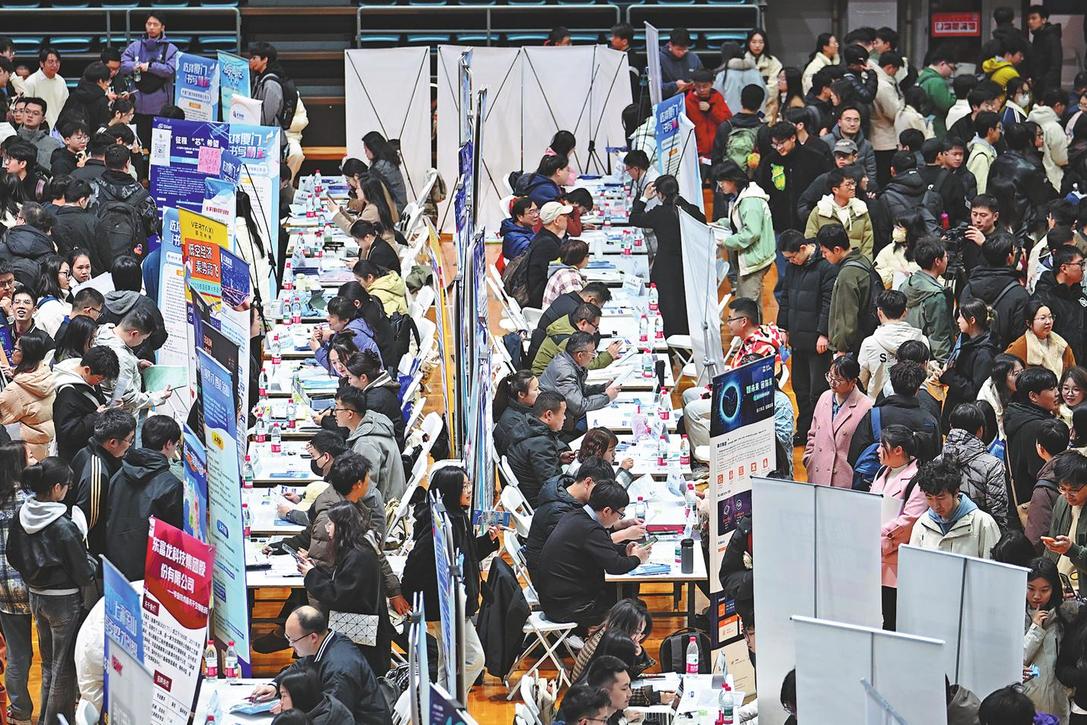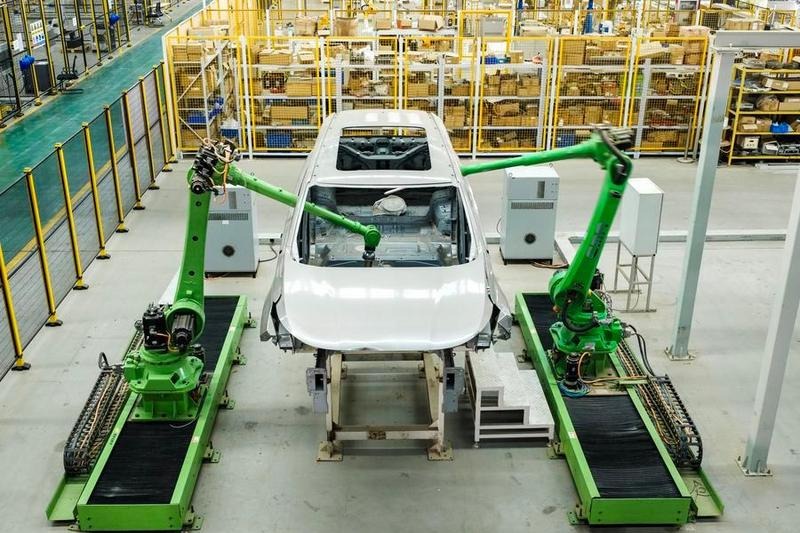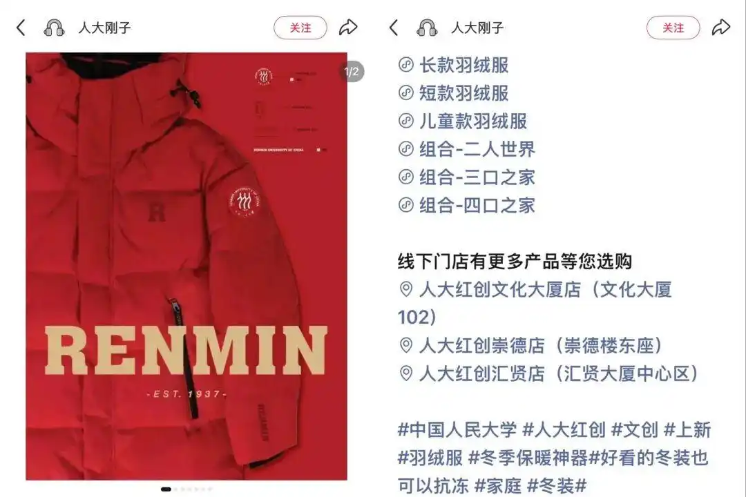Fine rhapsody

| Clockwise from above: Workers making musical instruments at a factory in Wuqiang county, Hebei province; A violin maker tests finished products; A customer plays on a drum set. Photos by Zhang Yu / China Daily |
Musical instrument makers in Wuqiang embrace modern technology to keep old craft alive
Soft strains of music wafting up from the various shops and factories in Wuqiang hardly give an inkling that the county is one of the leading manufacturers of wind musical instruments in the world. The relatively unknown county in Hebei province is also a major exporter of musical instruments such as flutes and clarinets.
China is already among the top six manufacturers in the world that collectively account for 90 percent of the musical equipment market, according to statistics provided by Music Trades, a well-known trade magazine that tracks the music industry.
Exports of Western musical instruments from China touched $1.66 billion (1.21 billion euros) in 2013, with markets covering 189 countries. The United States, the UK and Germany were the top destinations for these products, according to customs data.
Though Wuqiang's success is testimony to China's stature as a manufacturing powerhouse, it is also an ideal example of how some lesser-known Chinese counties are taking the manufacturing route to success, rather than the traditional farming-driven approach.
"Our products have been well received in Western markets, and are shipped to more than 30 countries like the US and Germany," says Chen Xuekong, manager of Hebei Jinyin Musical Instruments Manufacture Group Co Ltd, the funding company for the industry in Wuqiang.
Annual production of woodwind, brass, strings (essential parts for most musical instruments) and guitars exceeded a million pieces last year with an estimated output value of 426 million yuan ($68 million; 50 million euros). Nearly 85 percent of this was exported, Chen says.
"When we started, we were a small workshop in a rural area with 21 untried farmers. But in two decades, we have not only become a leading musical instrument maker, but also employ more than 2,600 skilled employees. In addition, we have played a big role in adding more jobs to the Hebei economy."
Yu Shaofeng, deputy director of the management committee of the economic zone in Wuqiang, says the success of the musical instruments industry has been an eye-opener for the county.
"The success indicates the promising future for Western musical instrument manufacturing and also provides new growth options and valuable industrialization tools for rural counties," Yu says.
Thanks to the pioneering role played by companies like Jinyin, there are now more than 51 companies making musical instruments, employing more than 5,500 workers. Some experts even liken Wuqiang to a musical instrument industry cluster.
The 51 companies posted combined sales of more than 750 million yuan in 2013 and 90 percent of the manufactured products were exported to 30 countries and regions in the world.

Wuqiang, however, has decided to further enhance its musical legacy by setting up a cultural industrial park to create a complete industrial system for musical instrument production, from research and design to maintenance, and also to be the first distribution center in China that combines production with marketing.
The local government has also announced a series of preferential policies such as rental concessions for three years and easier access to funds to attract more musical instrument manufacturing companies, Yu says.
Though preferential policies have been a major draw, several companies moved to Wuqiang to cash in on the natural synergies of industry concentration.
Sun Guangyou, who makes bottom and side plates for violins, was one of the entrepreneurs who relocated his factory from Harbin city in Heilongjiang province to Wuqiang last year.
He says that though it was easier to access necessary raw materials like wood in Harbin, the huge transportation costs made the whole business unviable. "Finished products had to be shipped frequently from Harbin to my customers, who were mostly in Hebei and southern provinces," Sun says.
"When I heard about the industrial park in Wuqiang, I decided to move in, so that I could be closer to my customers," he says, adding that his more than eight-year association with Jinyin Group was another motivator to move shop.
Unlike the huge costs involved in shipping finished products, the transportation costs for raw materials is relatively lower, Sun says. "Besides, when the zone is complete, I expect to team up with more companies to cut the raw material shipment costs."
Like Sun, many other companies have also set their sights on being part of the industrial cluster that is slowly taking shape in Wuqiang.
"There are other advantages like geographical location and climate that make Wuqiang an ideal manufacturing location," says Que Jianhua, manager of Hebei Third Brother Musical Instrument Co Ltd, which recently moved its manufacturing from Zhejiang to Wuqiang.
The county's proximity to Huanghua and Tianjin ports also makes it an attractive location for companies reliant on exports. Huanghua port, a major port in Hebei province, is 140 kilometers from Wuqiang, while Tianjin is about 220 km.
Dry weather is another factor that makes Wuqiang a better destination than the humid areas in eastern and southern provinces such as Guangzhou for companies, Que says.
"Musical instruments, like guitars, are susceptible to moisture during the manufacturing and shipping process. Dampness would lead to physical distortions and loss of market value," he says.
Preferential policies like rent exemptions have also helped manufacturers like Que. "The rent I paid in Zhejiang province was about 1.2 million yuan every year. It is much lower here."
With several upstream firms like Sun's panel making factory zeroing in on the new economic zone, it is also proving to be big business for e-commerce companies.
Liu Guang and his partners have been running an e-commerce website that sells musical instruments from a warehouse in Wuqiang since 2011. According to Liu, adequate stocks and the ability to offer lower prices have kept his business ticking. "Our sales have grown from 1 million yuan in 2011 to 6 million yuan last year," he says.
The burgeoning interest in musical instrument manufacture has also drawn several Western companies to Wuqiang. To date, there are three big Western musical instrument companies in Wuqiang that have invested about $729 million.
Among them, the under-construction project from GEWA, a large German company founded in 1925, is the biggest. The company plans to invest 1.56 billion yuan to build factories in the zone, which can produce 200,000 sets of drums, 150,000 sets of electronic drums, 100,000 guitars and other products every year.
"The project will allow the company to provide products for 150 companies in China, and the annual output value will be about 3 billion yuan," Yu Shaofeng, the management committee deputy director says. "The output value this year is expected to be about 500 million yuan."
The first phase of the project started pilot production last year and the entire project is expected to be complete by 2015.
However, there are also signs that like the rest of China, Wuqiang is also looking to move up the value chain by shifting to high-end products. Chen Xuekong, the manager from the Jinyin Group says that most of the products manufactured in the county are low-end products, more suited for training process.
"We must upgrade the product structure to offset losses from dwindling margins and stricter export requirements," Chen says.
China's export of musical instruments declined by 2.45 percent in 2013, the second drop in a decade. The first happened in 2009 due to the global financial crisis, according to customs data.
"We often get complaints from foreign customers about guitars, especially due to the poor craftsmanship in many workshops," says Wei Dong, an experienced guitar maker who spent most of his working life in Guangzhou city in Guangdong province.
He says that most of the problems arose due to the inexperience of the workers. "Nearly 60 percent of the workers are unskilled and experienced workers are hard to get," he says.
Quality concerns have also been raised by some of the foreign experts based in Wuqiang.
Boris Popovich, an expert in flutes who has worked in Wuqiang for about a year, says he is disappointed by the quality of flutes. "They are designed for beginners, not for professionals," he says.
The factories in Wuqiang must change their strategy and produce more high-value products of better quality, Popovich says.
Zeng Zemin, general secretary of China Musical Instruments Association, holds similar views and says industrial upgrade should be the top priority for musical instrument companies in Wuqiang.
"At the same time, it is not wise for Chinese companies to altogether abandon the manufacture of low-end products. But they should take the lead to be more professional in approach by improving the quality of products," he says.
"They need to pay more attention to research and development of high-end instruments, as it will allow them to realize higher profits," Zeng says.
With an emphasis on improving the overall quality of products, GEMA and a local company in Wuqiang have started the first phase of collaboration on a new guitar manufacture unit. The new line uses modern techniques and computer-aided technologies to reduce artificial errors and improve overall quality, Wei, says.
The production line can roll out 300,000 guitars a year, which will lower prices in the long run, he says.
In addition to improving quality, the musical instruments industry also needs more preferential policies to support their growth, says Zeng, the general secretary of the association.
Zhangyu contributed to this story.
zhengjinran@chinadaily.com.cn
(China Daily Africa Weekly 05/16/2014 page16)
Today's Top News
- UN envoy calls on Japan to retract Taiwan comments
- Innovation to give edge in frontier sectors
- Sanctions on Japan's former senior official announced
- Xi stresses importance of raising minors' moral standards
- Coordinated reform key to country's growth
- Shandong gives new life to traditions






























